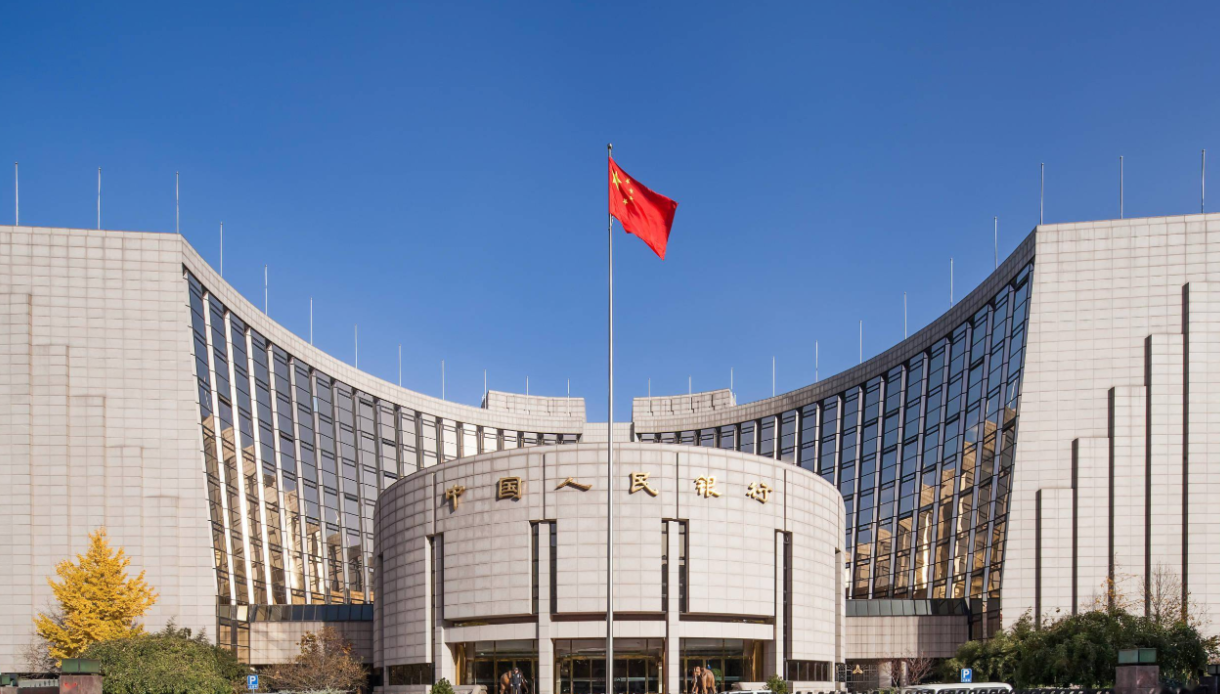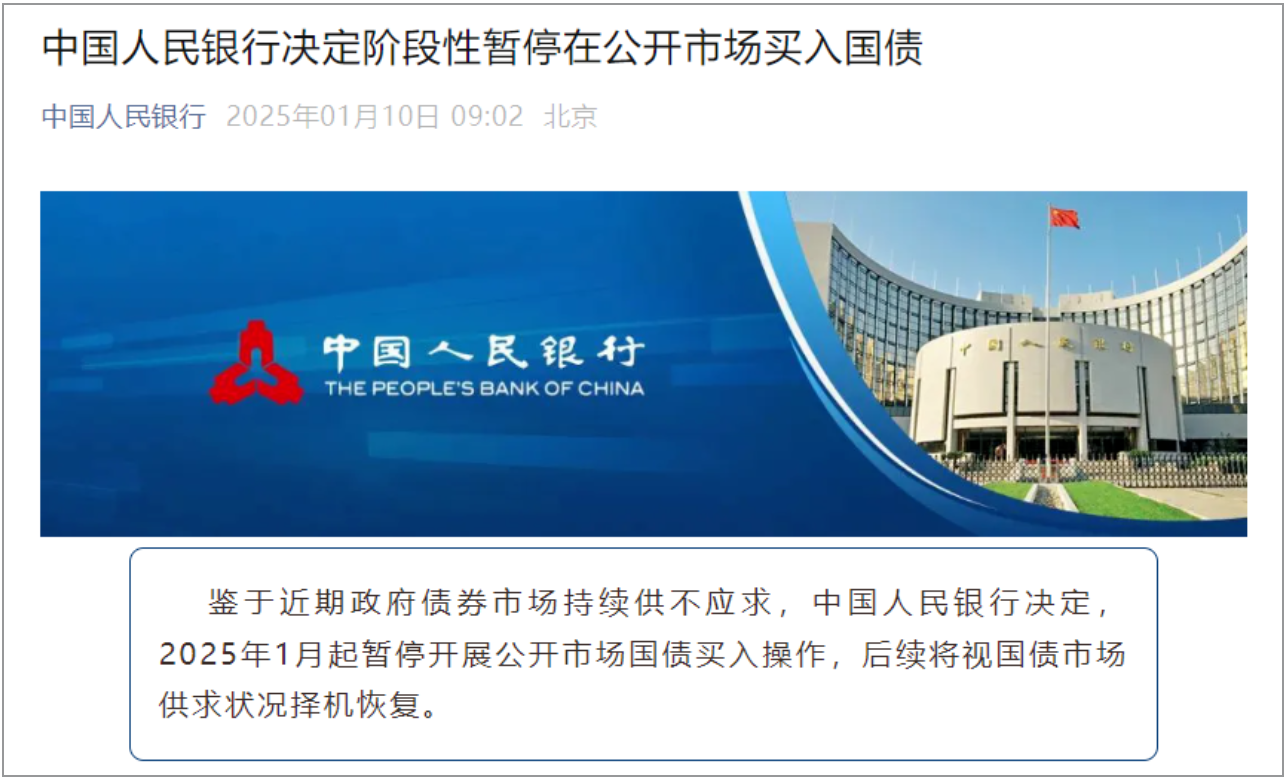
On January 10, the People's Bank of China announced that in view of the recent shortage of government bond market, the People's Bank of China decided to suspend the purchase of treasury bonds in the open market from January 2025, and will resume it at an opportune time depending on the supply and demand situation of the treasury bond market.

In just over ten minutes after the news was released, the yield of treasury bonds in the interbank market rose by about 3BP. The yield on the 240011 of the 10-year Treasury bond rose to 1.67% from 1.6425% before 9:00, and the yield on the 2400006 of the 30-year Treasury bond rose from 1.9125% to 1.95%, an increase of 2.75BP and 3.75BP, respectively.
According to the data, in 2024, the yield on 10-year Treasury bonds will fall from around 2.6% at the beginning of the year to around 1.6%, falling by nearly 100 basis points for the whole year. At the beginning of 2025, why did the central bank make the decision to temporarily suspend the purchase of treasury bonds in the open market?
The cost performance of long-term treasury bond investment has declined
As long-term Treasury yields move closer to the bottom of the historical experience corridor, their investment value has declined. In this context, treasury bonds and deposits can be regarded as alternative investment options, both of which have no credit risk but have their own characteristics.
The difference between Treasury bonds and deposits
Volatility: The price of treasury bonds will rise and fall with market changes, and has a certain degree of volatility; In contrast, deposits offer a fixed interest rate return without the risk of market price fluctuations.
Income characteristics: Historically, China's 10-year government bond yield has typically fluctuated above the Standing Lending Facility (SLF) rate and below the 3-year term deposit rate. At present, the yield of 10-year Treasury bonds is close to the 3-year time deposit rate, which means that the yield advantage of Treasury bonds through coupons is significantly weakened compared to deposits.
Currently, the yield on 10-year Treasury bonds is approaching the 3-year term deposit rate, suggesting that the investment attractiveness of Treasuries is decreasing. For investors who are looking for stable returns and are sensitive to price fluctuations, deposits can become a more attractive option. While Treasuries still offer some potential for capital appreciation, their volatility adds to uncertainty, especially as yield gaps narrow.
As the yield of the 10-year Treasury bond approaches the interest rate of the 3-year time deposit, the investment advantage of the treasury bond over the deposit has weakened significantly. For investors looking for low-risk, stable returns, now may be a good time to re-evaluate the relative value of these two investment vehicles. Deposits not only provide similar credit risk protection, but also avoid the risk of price fluctuations in Treasury bonds, making them a more stable option.
Expectations of interest rate cuts pushed the 10-year Treasury yield closer to the lower boundary
The market's response to "moderately accommodative" monetary policy has priced in significant rate cut expectations, with investors widely expecting more rate cuts in 2025 than in 2024, according to the Rate Cut Expectations Index. This expectation was significantly strengthened after the central government proposed a "moderately accommodative" monetary policy in December.
The impact of interest rate cut expectations
The rapid approach of the 10-year Treasury yield to the lower bound of its historical experience corridor is largely due to strong expectations of a rate cut. The rate cut expectation index, calculated through derivatives pricing, shows that investors' confidence in interest rate cuts in the coming year is growing. Looking at the index movement, this expectation has become particularly pronounced since the central government's announcement of a "moderately accommodative" monetary policy in December.
Changes in market sentiment
As interest rate cut expectations rise, investors have a clearer view of the future direction of monetary policy. This not only affects the pricing of the bond market, but also reflects the market's expectations for the economic outlook and policy response. For 10-year Treasury bonds in particular, the rapid decline in yields reflects the market's high sensitivity to changes in the medium- and long-term interest rate environment.
The possibility of secondary risks arising from the rapid decline in Treasury yields
In setting monetary policy targets, central banks need to focus not only on economic growth and price stability, but also on financial stability and balance of payments. In the second half of 2024, the central bank has repeatedly emphasized the issue of interest rate risk, especially on June 14, when the Financial Times published an article pointing out that "further interest rate cuts face internal and external 'double constraints'." Internally, banks' net interest margins continued to narrow. Externally, the RMB exchange rate is also a factor that must be taken into account. "Despite the many negative factors that currently exist, these risks are sometimes overlooked by investors, either intentionally or unintentionally. Therefore, the Financial Times calls on investors to pay more attention to the risk of price fluctuations in bond-like assets and protect their "money bags".
In the Monetary Policy Implementation Report for the Second Quarter of 2024 released in August, the PBOC made it clear that it would "conduct stress tests on the exposure of financial institutions to bond assets to guard against interest rate risks". This statement reflects the central bank's great importance to the stability of the financial market, aiming to ensure that financial institutions have sufficient resilience in the face of interest rate fluctuations.
With the gradual development of fiscal policy since the end of September, these concerns and constraints have eased for a while. However, the recent rapid decline in Treasury yields has put interest rate risk back in the spotlight of central banks. In this case, the central bank may pause purchases of government bonds in order to reassess market conditions and prevent potential financial instability from accumulating.
The central bank faces a complex internal and external environment in the operation of monetary policy. On the one hand, there is a need to balance multiple goals such as economic growth, price stability, financial stability, and balance of payments. On the other hand, there are specific challenges such as the narrowing of banks' net interest margins and the fluctuation of the RMB exchange rate. Against this backdrop, the PBOC has adopted a prudent attitude, closely monitored market dynamics, and adjusted policy tools in a timely manner to ensure the healthy and stable operation of the financial market. Investors should also raise their risk awareness, be cautious about investment decisions in bond-like assets, and jointly maintain the safety and sound development of the financial system.





